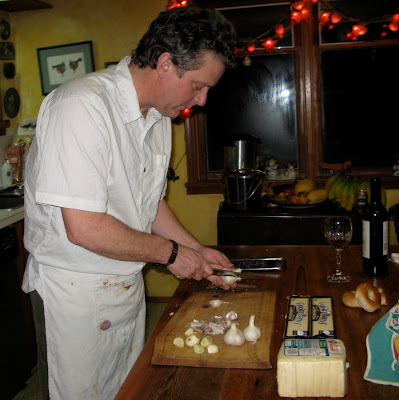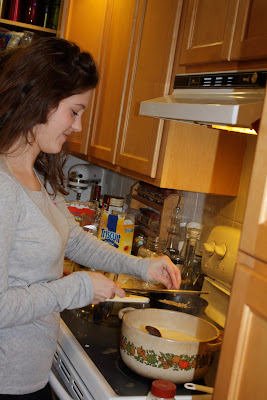There is not a more traditional Swiss food than the cheese fondue. There is some controversy over the origins of the cheese fondue. Some believe the fondue's origins was as a "peasant" rustic dish from the mountains, made as a means to use up dry, old cheese. Others state that the fondue started among the wealthier people as it used expensive cheeses, primarily Gruyere and Emmenthal, however different cantons in Switzerland have their own cheeses that they like to use in their fondue.
The first published recipe for the cheese fondue using cheese and wine was in 1875, and was presented as the Swiss national dish. With the invention of corn starch in 1905, which allowed the fondue to have a creamier consistency, the cheese fondue gained in popularity. In the 1930s the Swiss Cheese Union actively promoted the dish as a means to increase cheese consumption. Through the activities of the Swiss Cheese Union the fondue spread across Switzerland, with regional dishes being created, and slowly the fondue became a symbol of Swiss unity. Before World War 11 the promotion of the cheese fondue was part of the "spiritual defense of Switzerland". (credits to Wikipedia).
Cheese fondue has been enjoyed on the Ranch for years. Gus was the only person who made this dish until the arrival of Brent, my husband. Brent very quickly took an interest in the fondue, and became Gus's sous chef until he had mastered the recipe. The fondue is one of those recipes that is best learned through observation. It is a wonderful communal dish that lends itself to large gatherings, bringing guests together as they learn the intricacies of the dish, both the creation and the consumption.
2002. Mico, our oldest son, watching Gus add wine to the cheese. Mico had dressed in yellow shirt and blue pants to match his grandfather for his first lesson in fondue making.
Christmas Eve 2010. Brent has been making Gus's fondue for over 20 years. It is one of those dishes that is different each time. We have made a few modifications, suggested originally by Gus, to adjust to what is available in our Canadian grocery stores. We often use a combination of extra aged cheddar and Havarti instead of Gruyere and Emmenthal. I prefer the Gruyere and Emmenthal but they are very expensive to purchase here.
Our beautiful fondue pot and stand given as a wedding gift from my Aunt Michele and Uncle Paul. It is important to use a caquelon, a heavy earthenware dish, for even heat distribution. The fondue is cooked on the stove and then transferred to the table and kept warm with an alcohol heater. Long fondue forks are used to dip the bread into the cheese. Proper etiquete is to carefully eat the bread off the fork without touching the fork with your mouth as it gets dipped back into the pot.
The first step to the creation of the fondue is to rub the bottom of the pot with chopped up garlic. About one clove for a large fondue pot (Brent always adds more garlic, this is where the magic lies).
The grated cheese is added to the pot and the pot filled to one third of the level of the cheese with dry white wine (the wine is best cheap and very dry).
The cheese is slowly melted over low heat.
Christmas Eve 2011, Brent with our friend Ian demonstrating the spoon to be used to stir the fondue. This spoon is actually a Scottish of origin, however very similar to the fondue spoon, the key being to have a hole in the spoon.
Kirsch, a cherry liqueur, is the other expensive ingredient for the fondue. This is used to mix with the cornstarch to prevent the cheese mixture from separating.
The Kirsch is mixed with about a tablespoon of cornstarch making a milky looking mixture. When I was a young child my grandpa Gus fooled me once into thinking the glass was milk, and I drank a good portion of it. I thought at the time that it tasted terrible but now as an adult I like Kirsch. Kirsch mixture is mixed into the cheese and allowed to cook until it looks like the cheese is about to boil over. A small amount of nutmeg is grated into the fondue at this point and then the pot is moved to the dining table.
Fresh nutmeg being grated into the fondue.
Christmas Eve 2010. We often serve the fondue with fresh cut up vegetables, and dip those into the fondue instead of the bread. This is something that is never done by our family in Switzerland who would not even serve salad with the fondue. I find it amusing to see how immigrants add their own flavour to traditions. The bread best used is a crunchy baguette.
Christmas Eve 2011. The bottle of pop on the table is not a recommended beverage to have with a fondue. To avoid a stomach ache it is best to consume tea or wine. There is some that would declare that white wine is the preferred choice however the right type of red is also a good pairing. We served the fondue above with small glasses of Kirsch. The Kirsch could either be sipped or the bread piece could be dipped into the Kirsch before going in the cheese.
The fondue forms part of our family's "spiritual defence" as we struggle with loss. For over 20 years now it has formed one of the many ties that we share with family in Switzerland. It is fun to share the many fondue rituals with our guests, such as when a man drops his bread in the fondue pot he has to buy the next bottle of wine, and when a woman drops her bread she has to kiss everyone at the table. It is always a good night when we dust off the fondue pots and start grating cheese.
The first published recipe for the cheese fondue using cheese and wine was in 1875, and was presented as the Swiss national dish. With the invention of corn starch in 1905, which allowed the fondue to have a creamier consistency, the cheese fondue gained in popularity. In the 1930s the Swiss Cheese Union actively promoted the dish as a means to increase cheese consumption. Through the activities of the Swiss Cheese Union the fondue spread across Switzerland, with regional dishes being created, and slowly the fondue became a symbol of Swiss unity. Before World War 11 the promotion of the cheese fondue was part of the "spiritual defense of Switzerland". (credits to Wikipedia).
Cheese fondue has been enjoyed on the Ranch for years. Gus was the only person who made this dish until the arrival of Brent, my husband. Brent very quickly took an interest in the fondue, and became Gus's sous chef until he had mastered the recipe. The fondue is one of those recipes that is best learned through observation. It is a wonderful communal dish that lends itself to large gatherings, bringing guests together as they learn the intricacies of the dish, both the creation and the consumption.
2002. Mico, our oldest son, watching Gus add wine to the cheese. Mico had dressed in yellow shirt and blue pants to match his grandfather for his first lesson in fondue making.
Christmas Eve 2010. Brent has been making Gus's fondue for over 20 years. It is one of those dishes that is different each time. We have made a few modifications, suggested originally by Gus, to adjust to what is available in our Canadian grocery stores. We often use a combination of extra aged cheddar and Havarti instead of Gruyere and Emmenthal. I prefer the Gruyere and Emmenthal but they are very expensive to purchase here.
Our beautiful fondue pot and stand given as a wedding gift from my Aunt Michele and Uncle Paul. It is important to use a caquelon, a heavy earthenware dish, for even heat distribution. The fondue is cooked on the stove and then transferred to the table and kept warm with an alcohol heater. Long fondue forks are used to dip the bread into the cheese. Proper etiquete is to carefully eat the bread off the fork without touching the fork with your mouth as it gets dipped back into the pot.
The first step to the creation of the fondue is to rub the bottom of the pot with chopped up garlic. About one clove for a large fondue pot (Brent always adds more garlic, this is where the magic lies).
The grated cheese is added to the pot and the pot filled to one third of the level of the cheese with dry white wine (the wine is best cheap and very dry).
The cheese is slowly melted over low heat.
Christmas Eve 2011, Brent with our friend Ian demonstrating the spoon to be used to stir the fondue. This spoon is actually a Scottish of origin, however very similar to the fondue spoon, the key being to have a hole in the spoon.
Kirsch, a cherry liqueur, is the other expensive ingredient for the fondue. This is used to mix with the cornstarch to prevent the cheese mixture from separating.
The Kirsch is mixed with about a tablespoon of cornstarch making a milky looking mixture. When I was a young child my grandpa Gus fooled me once into thinking the glass was milk, and I drank a good portion of it. I thought at the time that it tasted terrible but now as an adult I like Kirsch. Kirsch mixture is mixed into the cheese and allowed to cook until it looks like the cheese is about to boil over. A small amount of nutmeg is grated into the fondue at this point and then the pot is moved to the dining table.
Fresh nutmeg being grated into the fondue.
Christmas Eve 2010. We often serve the fondue with fresh cut up vegetables, and dip those into the fondue instead of the bread. This is something that is never done by our family in Switzerland who would not even serve salad with the fondue. I find it amusing to see how immigrants add their own flavour to traditions. The bread best used is a crunchy baguette.
Christmas Eve 2011. The bottle of pop on the table is not a recommended beverage to have with a fondue. To avoid a stomach ache it is best to consume tea or wine. There is some that would declare that white wine is the preferred choice however the right type of red is also a good pairing. We served the fondue above with small glasses of Kirsch. The Kirsch could either be sipped or the bread piece could be dipped into the Kirsch before going in the cheese.
The fondue forms part of our family's "spiritual defence" as we struggle with loss. For over 20 years now it has formed one of the many ties that we share with family in Switzerland. It is fun to share the many fondue rituals with our guests, such as when a man drops his bread in the fondue pot he has to buy the next bottle of wine, and when a woman drops her bread she has to kiss everyone at the table. It is always a good night when we dust off the fondue pots and start grating cheese.






























No comments:
Post a Comment